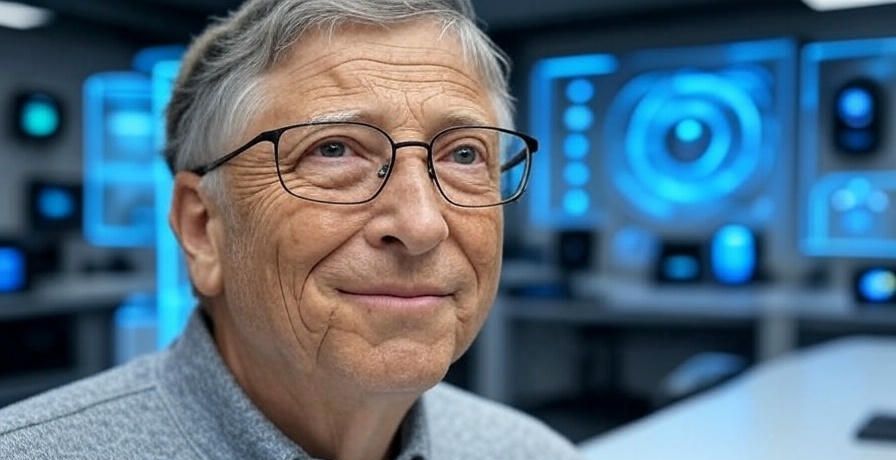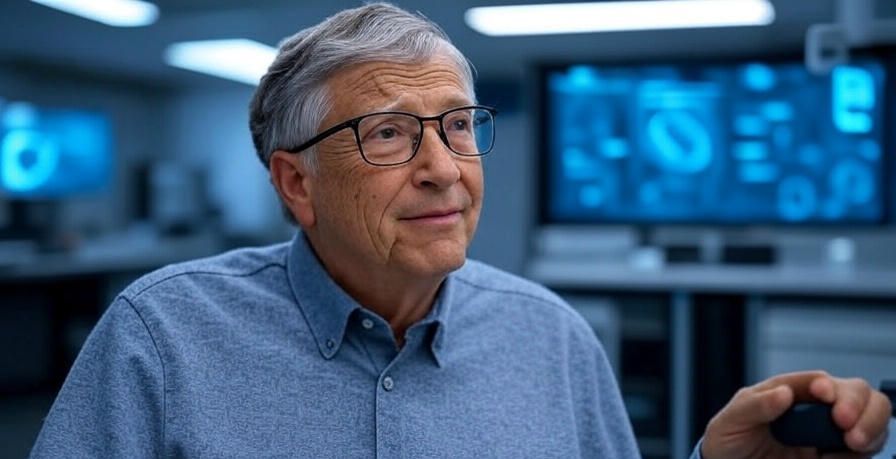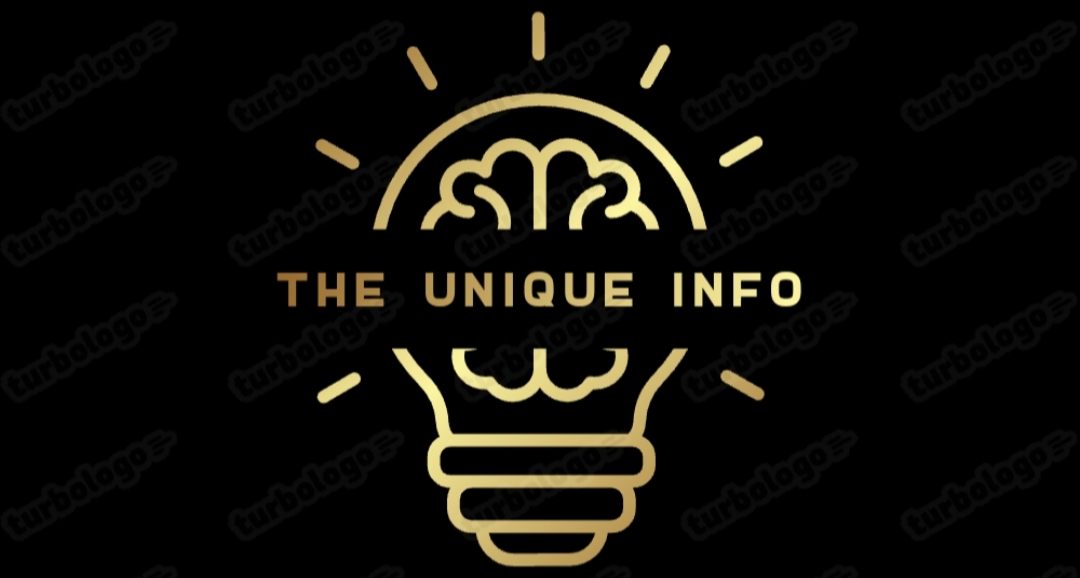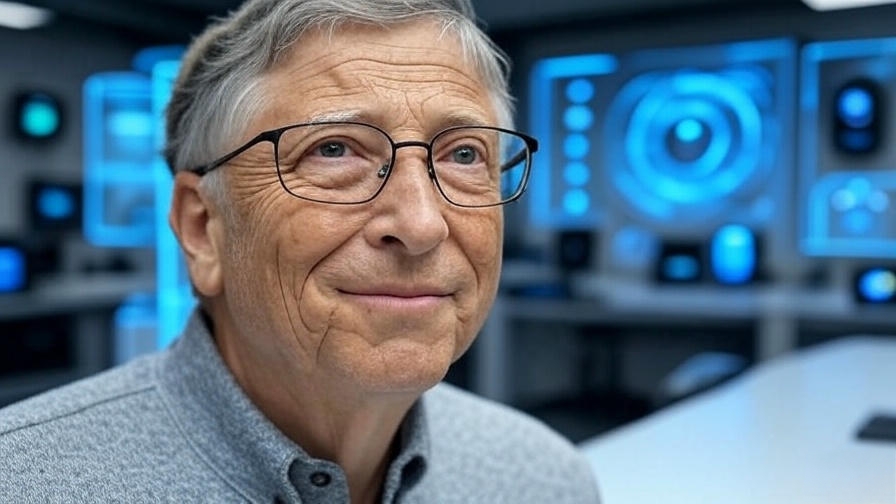Bill Gates is a name that resonates with technology, innovation, and philanthropy. As the co-founder of Microsoft Corporation, he played a pivotal role in shaping the digital age, making computers a household staple. Beyond his tech legacy, Gates has become one of the world’s most influential philanthropists through the Bill & Melinda Gates Foundation. This article explores the life, achievements, and impact of Bill Gates in a simple and detailed way, suitable for readers of all ages and backgrounds. From his early days in Seattle to his global efforts to improve health and education, let’s dive into the story of a man who transformed the world.

𝗘𝗮𝗿𝗹𝘆 𝗟𝗶𝗳𝗲 𝗮𝗻𝗱 𝗕𝗮𝗰𝗸𝗴𝗿𝗼𝘂𝗻𝗱
William Henry Gates III, widely known as Bill Gates, was born on October 28, 1955, in Seattle, Washington. He grew up in a supportive and well-off family. His father, William H. Gates Sr., was a successful lawyer, and his mother, Mary Maxwell Gates, was a schoolteacher and a civic leader who served on various boards, including the University of Washington. Bill was the middle child, with an older sister, Kristi, and a younger sister, Libby. His family nicknamed him “Trey” because of the “III” in his name.
As a child, Bill was curious and competitive. He loved reading and would spend hours buried in books—so much so that his parents once banned him from bringing books to the dinner table! His early exposure to education was at Lakeside School, a private school in Seattle, where he first encountered computers at the age of 13. Lakeside had a computer club, which was rare for the 1960s, and it was here that Gates met Paul Allen, a fellow student two years his senior. The two bonded over their shared love for computers and programming.
At Lakeside, Gates wrote his first software program—a tic-tac-toe game that allowed users to play against the computer. He and Allen also formed a group called the Lakeside Programmers Club, where they worked on projects like computerizing the school’s payroll system. Gates showed early signs of brilliance, scoring 1590 out of 1600 on his SATs, one of the highest scores recorded at the time. In 1973, he enrolled at Harvard University, but his passion for computers would soon take him down a differentpath.

𝗧𝗵𝗲 𝗕𝗶𝗿𝘁𝗵 𝗼𝗳 𝗠𝗶𝗰𝗿𝗼𝘀𝗼𝗳𝘁
While at Harvard, Gates continued to explore programming. He took challenging courses like Math 55 and graduate-level computer science classes, but he wasn’t fully committed to academics. In 1974, during a break, he joined Paul Allen at Honeywell, where Allen was working. That same year, a pivotal moment occurred: Allen showed Gates a magazine featuring the Altair 8800, the world’s first personal computer, developed by a company called MITS.
Gates and Allen saw an opportunity. They contacted MITS and offered to write a version of the BASIC programming language for the Altair. Despite not having an Altair or a finished product, they worked tirelessly in Harvard’s computer labs to create the software. Their hard work paid off—MITS was impressed, and in 1975, Gates dropped out of Harvard to co-found Microsoft with Allen in Albuquerque, New Mexico, where MITS was based. The name “Microsoft” was a blend of “microcomputer” and “software,” reflecting their focus on software for personal computers.
Microsoft’s big break came in 1980 when they signed a deal with IBM to develop an operating system for the IBM PC. Gates and Allen licensed a system called QDOS (Quick and Dirty Operating System) from another company, modified it, and renamed it MS-DOS. In a brilliant business move, Microsoft retained the rights to license MS-DOS to other manufacturers, leading to the rise of “IBM-compatible” PCs that all ran Microsoft’s software. This decision laid the foundation for Microsoft’s dominance in the personal computer industry.
𝗕𝘂𝗶𝗹𝗱𝗶𝗻𝗴 𝗮 𝗧𝗲𝗰𝗵 𝗘𝗺𝗽𝗶𝗿𝗲
Under Gates’ leadership, Microsoft grew rapidly. In 1981, the company incorporated, with Gates as president and chairman. By 1985, Microsoft launched Windows, a graphical operating system that made computers more user-friendly. Windows became a global standard, and by the 1990s, Microsoft controlled over 90% of the personal computer software market. Gates’ vision of “a computer on every desk and in every home” became a reality.
Gates served as Microsoft’s CEO until 2000, overseeing the launch of iconic products like Microsoft Office, Internet Explorer, and Windows 95. His leadership style was intense—he was known for being demanding and detail-oriented, often reviewing code himself and pushing his team to innovate. In 1986, Microsoft went public, and Gates became a billionaire at the age of 31, the youngest person to achieve that milestone at the time. By 1999, his net worth briefly surpassed $100 billion, making him the world’s first centibillionaire.
However, Microsoft’s success wasn’t without controversy. In the late 1990s, the company faced a major antitrust lawsuit from the U.S. government, which accused Microsoft of monopolistic practices, particularly with its bundling of Internet Explorer with Windows. The legal battle was a challenging period for Gates, but Microsoft eventually settled the case in 2001, agreeing to share its technology with competitors.
In 2000, Gates stepped down as CEO, handing the role to Steve Ballmer, a longtime friend and Harvard classmate. Gates transitioned to chief software architect, and later, in 2014, he stepped down as chairman, becoming a technology adviser to CEO Satya Nadella. By 2020, Gates had resigned from Microsoft’s board entirely to focus on his philanthropic work, though he still holds a small stake in the company (less than 1% as of 2025).
𝗧𝗵𝗲 𝗕𝗶𝗹𝗹 & 𝗠𝗲𝗹𝗶𝗻𝗱𝗮 𝗚𝗮𝘁𝗲𝘀 𝗙𝗼𝘂𝗻𝗱𝗮𝘁𝗶𝗼𝗻
In 2000, Gates and his then-wife, Melinda French Gates, founded the Bill & Melinda Gates Foundation, merging several family foundations into what would become the world’s largest private charitable organization. The foundation’s mission is to improve global health, reduce poverty, and expand access to education. Gates was inspired by the philanthropy of figures like Andrew Carnegie and John D. Rockefeller, and he saw an opportunity to use his wealth to tackle some of the world’s biggest problems.
The foundation has had a transformative impact. Since its inception, it has donated over $100 billion to causes like eradicating diseases (such as polio, malaria, and HIV/AIDS), improving maternal and child health, and supporting education. One of its most significant achievements is its partnership with Gavi, the Vaccine Alliance, which has helped immunize over 760 million children and prevent more than 13 million deaths since 2000. The foundation also played a key role in certifying the African region as wild polio-free in 2020.
Gates has been deeply involved in the foundation’s work, serving as its chair and shaping its strategies. In 2022, he announced a $20 billion gift to the foundation, and in 2025, he committed to spending down its endowment—along with most of his personal fortune—over the next 20 years, with plans to close the foundation by 2045. This decision was influenced by global challenges, including cuts to foreign aid under the Trump administration, which Gates has publicly criticized. He believes that accelerating the foundation’s giving can make a bigger impact in the short term, especially in areas like global health and human development.
𝗚𝗮𝘁𝗲𝘀’ 𝗟𝗲𝗮𝗱𝗲𝗿𝘀𝗵𝗶𝗽 𝗦𝘁𝘆𝗹𝗲 𝗮𝗻𝗱 𝗣𝗵𝗶𝗹𝗼𝘀𝗼𝗽𝗵𝘆
Bill Gates is known for his analytical and visionary approach. His leadership style at Microsoft was hands-on—he was deeply involved in product development and often challenged his team to think bigger. He believed in the power of software to change lives, a belief that drove Microsoft’s mission. Gates also emphasized data-driven decision-making, a principle that carried over into his philanthropy, where he relies on research and measurable outcomes to guide the foundation’s work.
Gates is a lifelong learner. He reads about 50 books a year and shares his insights through his blog, Gates Notes, where he writes about topics like global health, climate change, and technology. He’s also known for his “Think Weeks,” where he takes time off to read and reflect on big ideas. Gates’ curiosity and optimism have shaped his approach to both business and philanthropy—he believes that innovation and collaboration can solve even the toughest problems.
𝗞𝗲𝘆 𝗔𝗰𝗵𝗶𝗲𝘃𝗲𝗺𝗲𝗻𝘁𝘀 𝗮𝗻𝗱 𝗜𝗺𝗽𝗮𝗰𝘁
Bill Gates’ contributions to technology and philanthropy are monumental. Here are some of his most notable achievements:
✓ Microsoft’s Legacy: Gates co-founded Microsoft, which revolutionized personal computing. Today, Windows powers over 1 billion devices worldwide, and Microsoft remains a leader in software, cloud computing, and AI.
✓ Global Health: Through the Gates Foundation, Gates has saved tens of millions of lives by funding vaccines, disease eradication, and healthcare improvements. The foundation’s work has reduced childhood deaths significantly—global under-5 mortality fell from 77 per 1,000 births in 2000 to 37 in 2023.
✓ Education and Poverty: The foundation has invested billions in education, providing scholarships and improving access to learning. It also supports initiatives to reduce extreme poverty, which dropped by three-quarters between 1990 and 2014, partly due to global health advancements.
✓ Climate and Innovation: Gates founded Breakthrough Energy in 2015 to support clean energy solutions and combat climate change. He’s also an advocate for AI, believing it can transform industries like healthcare and education, though he stresses the need for equitable access.
✓ Philanthropy Pledge: In 2010, Gates and Warren Buffett launched the Giving Pledge, encouraging billionaires to donate at least half their wealth to charity. Gates has pledged to give away 99% of his fortune, which stands at $115.1 billion as of May 2025, making him the 13th-richest person in the world.
Gates’ impact has earned him numerous honors, including being named one of TIME’s 100 Most Influential People and receiving the James C. Morgan Global Humanitarian Award in 2006.
𝗖𝗵𝗮𝗹𝗹𝗲𝗻𝗴𝗲𝘀 𝗮𝗻𝗱 𝗖𝗼𝗻𝘁𝗿𝗼𝘃𝗲𝗿𝘀𝗶𝗲𝘀
Gates’ journey hasn’t been without challenges. Microsoft’s antitrust lawsuit in the 1990s damaged its reputation, and Gates was often portrayed as a ruthless “robber baron.” His public image shifted in the 2000s as he focused on philanthropy, earning him praise as a “huggable billionaire techno-philanthropist.” However, his 2021 divorce from Melinda French Gates brought renewed scrutiny, with reports of past romantic pursuits of employees, a long-term extramarital affair, and a friendship with Jeffrey Epstein, a convicted sex offender. These revelations complicated his public persona.
The Gates Foundation has also faced criticism. Some argue that its focus on measurable outcomes overlooks systemic issues, while others question the influence of a private foundation on global health policy. Gates has acknowledged these critiques but remains committed to his mission, emphasizing transparency and collaboration with governments and organizations.
𝗣𝗲𝗿𝘀𝗼𝗻𝗮𝗹 𝗟𝗶𝗳𝗲 𝗮𝗻𝗱 𝗟𝗲𝗴𝗮𝗰𝘆
Bill Gates married Melinda French in 1994, and they have three children: Jennifer, Rory, and Phoebe. The couple worked closely together at the foundation until their divorce in 2021, after 27 years of marriage. Gates has spoken fondly of his family, crediting his parents for instilling values of hard work and generosity. His father, who passed away in 2020, was a co-chair of the foundation and a major influence on Gates’ philanthropy.
In his personal life, Gates is an avid reader and traveler. He published his first memoir, Source Code, in February 2025, which reflects on his childhood and early days at Microsoft. He continues to blog on Gates Notes, sharing his thoughts on books, technology, and global issues. Gates also enjoys playing bridge and has a deep admiration for historical figures like Kay Graham, the former publisher of The Washington Post.
As of 2025, Gates remains active in philanthropy and innovation. His decision to close the Gates Foundation by 2045 reflects his belief that urgent action is needed to address global crises. He’s also focused on climate change through Breakthrough Energy and continues to advocate for AI and healthcare advancements.
𝗪𝗵𝗮𝘁 𝗖𝗮𝗻 𝗪𝗲 𝗟𝗲𝗮𝗿𝗻 𝗳𝗿𝗼𝗺 𝗕𝗶𝗹𝗹 𝗚𝗮𝘁𝗲𝘀?
Bill Gates’ life offers valuable lessons for everyone:
✓ Follow Your Passion: Gates dropped out of Harvard to pursue his love for computers, showing that passion can lead to great success.
✓ Think Long-Term: His vision for Microsoft and the Gates Foundation demonstrates the power of planning for the future.
✓ Give Back: Gates’ commitment to philanthropy reminds us of the importance of using our resources to help others.
✓ Stay Curious: His love for learning and reading shows that curiosity drives innovation and growth.
✓ Collaborate: Gates’ partnerships with Paul Allen, Melinda, and global organizations highlight the value of teamwork.
𝗧𝗵𝗲 𝗙𝘂𝘁𝘂𝗿𝗲 𝗼𝗳 𝗕𝗶𝗹𝗹 𝗚𝗮𝘁𝗲𝘀’ 𝗩𝗶𝘀𝗶𝗼𝗻
Looking ahead, Gates is focused on tackling big challenges. Through the Gates Foundation, he aims to spend over $200 billion in the next 20 years to fight diseases, reduce inequality, and improve education. His work with Breakthrough Energy is pushing for sustainable solutions to climate change, and he’s advocating for AI to benefit all of humanity, not just the wealthy.
Gates’ legacy is already immense. He transformed technology with Microsoft, saved millions of lives through philanthropy, and inspired a generation to think big. Whether you’re using a Windows computer, benefiting from a vaccine funded by his foundation, or reading his blog, you’re experiencing the impact of Bill Gates. His story shows that with vision, determination, and a desire to make a difference, one person can truly change the world.

